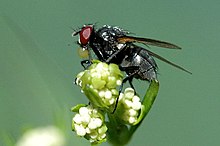Hydrotaea
| Hydrotaea | |
|---|---|
 |
|
| Female Hydrotaea diabolus | |
| Scientific classification | |
| Kingdom: | Animalia |
| Phylum: | Arthropoda |
| Class: | Insecta |
| Order: | Diptera |
| Family: | Muscidae |
| Subfamily: | Azeliinae |
| Tribe: | Azeliini |
| Genus: |
Hydrotaea Robineau-Desvoidy, 1830 |
| Type species | |
|
Musca meteorica Linnaeus, 1758 |
|
| Synonyms | |
|
|
Hydrotaea is a genus of insects in the housefly family, Muscidae. They occur in most regions of the world but are more populous in warmer climates. They are often found on feces in summer months, and are therefore generally found in close proximity to . Among the 130 known species in this genus, one of the most commonly recognized is the dump fly.
Along with many others genera in the family, Hydrotaea is of forensic importance in both the economic and public health scene. Flies in general are considered by many authorities to be the most important insects involved in human and veterinary medicine. Certain Hydrotaea species have been proven to carry and transmit certain diseases to warm blooded animals, including humans. Researchers continue to monitor these vectors of disease as they have been connected with the spread of mastitis.
There are 130 known species in this genus. They include:
Larvae of this genus are often dimorphic obligate carnivores. The second and third instars are predators, and the first is also carnivorous in some species. Some species have cannibalistic final instars. The smallest larvae are under 6 mm and the largest are up to 16 mm. The abdomen has ventral welts and large spiracles with sinuate slits.
Adults commonly feed on the blood of mammals. They are able to reopen wounds that are almost completely healed. Mouthpart morphology in the genus ranges from sponging mouthparts to mouths with rasping teeth. Many species have enlarged prestomal teeth. The metathoracic spiracle is covered in long, thick setae. The average male Hydrotaea is 6.5-8.5 mm and the average female is 5.75-7.5 mm. They are very light brown to bluish black with large, red eyes and plumose antennae.
...
Wikipedia
